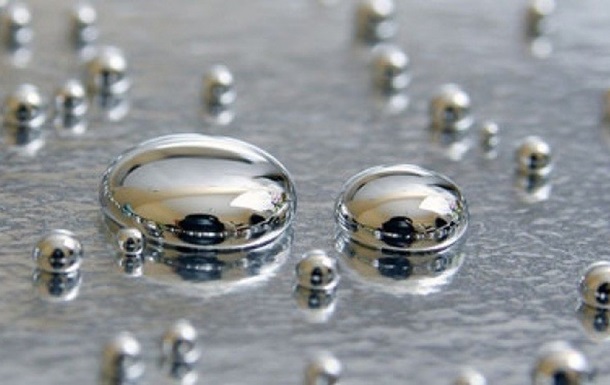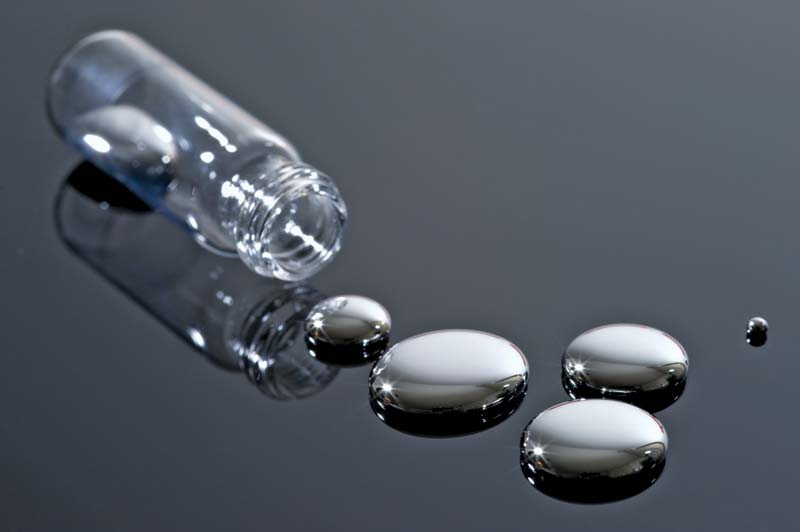Mercury has been used since ancient times for metalworking and – unsuccessfully – as a tool. The heavy metal has amazing properties, but it is also very toxic and ubiquitous due to environmental pollution.
Many people know only mercury thermometers, in which a multi-colored liquid rises and falls through a glass tube at the entrance of their parents or grandparents. They work because mercury is liquid at room temperature. It shrinks in cold weather and expands in warm weather. But if he escapes, the heavy metal can vaporize and cause poisoning. Mercury thermometers are no longer manufactured in Germany.
Mercury poisoning is now rare. Heavy metal still permeates nature due to environmental pollution, we humans consume small amounts of food and dental amalgam fillings.
Find out how mercury enters our body and what it is capable of in this article. We explain which foods are common, how to avoid them, and how chelation therapy removes heavy metals from your body in the event of mercury poisoning.
What is mercury?
The ancient Romans associated the liquid shiny silver heavy metal with the messenger god Mercury and called him Mercury. The word “hydragirum”, “liquid silver”, was later translated from Greek into Latin – hence the symbol of the chemical element Hg. Because of its unique properties, ancient people used mercury, especially because it is liquid at room temperature and evaporates very early. The heavy metal continues to find industrial applications, such as energy saving lamps for mercury vapor lamps.
Mercury as a “medicine”
Attempts to use mercury as a medicine have been less successful. In antiquity and the Middle Ages, it was used as a “gray ointment” for leprosy and skin diseases. The famous physician Paracelsus vowed to use mercury ointments against syphilis in the 16th century. At the same time, he observed mercury poisoning in miners and presumably died of chronic heavy metal poisoning.
Mercury poisoning from drugs
Even today, mercury, along with toxic lead, is also found in questionable amounts in some old “home ointments” and traditional Asian medicines, such as Ayurvedic medicines from India and Sri Lanka. These drugs sometimes lead to severe poisoning.
Impressive case: A German tourist received black beads at an Ayurvedic spa hotel in Sri Lanka. Back in Germany, she suffered from weight loss, fatigue, and reduced performance. The doctor diagnosed him with severe mercury poisoning. The balls exceeded the limit values for mercury by 2.3 million times. Two other German couples contracted mercury poisoning in Sri Lanka due to similar Ayurvedic treatments.
Environmental pollution with mercury
Mercury is found in the earth’s crust, from where it naturally enters the environment. Volcanoes release it into the atmosphere, and it ends up in sediments in the soil and ocean.
But this Mercury pollution of the environment has increased significantly thanks to people. We mine the heavy metal specifically from mercury mines, usually from the mercury-containing mineral cinnabar ore, and identify it as a by-product of other metals such as zinc, copper, gold and silver. In addition, it is sometimes used to extract gold from unclean ores. For example, illegal gold mines in South America and Indonesia pollute the environment with mercury-containing wastewater and vapors.
Did you know? Mercury is released into the air not only when coal is burned, but also when amalgam fillers are cremated. Because of mercury and other pollutants, modern silicon systems today often operate in crematoria.
How does mercury get into the air?
The emissions of mercury into the air come from the energy sector, especially from coal-fired power plants. Mercury can be widely distributed in the air and is associated with dust particles and precipitation in the soil and in rivers, lakes and seas.
Various measures and regulations have reduced mercury emissions by more than 70 percent since the 1990s. However, the mercury that we have released into the environment over the past 150 years is not just disappearing. Large amounts of heavy metal.
Still stored in sediment in soil and oceans.
Minamata Convention: The European Union, Germany and many other countries signed the Minamata Convention in 2013 to the UN Convention. States Parties want to reduce global mercury pollution through a convention. In Germany, from 2020, for example, the production and sale of lamps and thermometers with mercury will be prohibited.
Exposure to mercury in daily life
Most people get mercury when we eat certain types of fish, including sharks, swordfish, tuna, halibut, eel, pike, and marlin. Dolphins and whales, which are still on the menu in Japan and the Faroe Islands, are also heavily burdened. What these fish have in common: They are long-lived large carnivorous fish that are high in the food chain.
Why are large fish so heavily contaminated with mercury?
Mercury from environmental pollution accumulates in algae and plankton, mainly in the form of so-called methylmercury compounds. These organic compounds are the most problematic form of mercury for our health. Our gastrointestinal tract can absorb them well and distribute them through the bloodstream in the body.
Small crustaceans, mussels and fish feed on plankton and algae and accumulate methylmercury. The collected heavy metal then enters the stomach of the predatory fish, whose menu contains small animals. They also accumulate mercury until they are eaten by larger predators. The larger and older the predatory fish gets, the more mercury is gradually released from the food chain.
Good to know: Fish species that are not highly contaminated with mercury include saithe, flounder and herring, as well as farmed fish such as trout and carp.
What other foods are contaminated with mercury?
Rice, cereals, mushrooms, vegetables, fruits, nuts, cocoa and meat contain mercury, but to a much lesser extent than fish and seafood. In addition, these products usually contain elemental mercury and inorganic mercury compounds that are poorly absorbed through the intestines and are considered less hazardous.
Mercury in energy-saving lamps
Energy saving lamps and fluorescent lamps work with mercury vapor – therefore, there is always a warning about the danger of poisoning in case of lamp breakage. Energy saving lamps today can contain as little as 2.5 milligrams of mercury. Even if you inhaled the entire amount – which is highly unlikely – it will not be enough to cause poisoning. In addition, lamps usually break when we change the light bulb, which means when it is already cold. In this case, no more than a small part of the mercury evaporates, the rest sticks to the lamp glass.
If the energy-saving lamp fails, follow some safety measures:
- Ventilate, turn off heating and air conditioning and leave the room for 15 minutes.
- Collect the fragments with a disposable glove.
- Do not remove stubborn and small residues with a vacuum cleaner, but with tape or damp paper towels.
- Collect waste in an airtight container, such as an empty jam jar. Do not store waste on site and dispose of it as special waste, for example at a collection point for pollutants.
The same procedure can be used for broken old mercury thermometers.
Amalgam fillings
When mercury meets some other metals such as silver, tin and copper, it forms alloys with them. These metallic mixtures containing mercury are called amalgams. They have been used in dentistry for over 150 years, are easy to manufacture and resistant, relatively cheap, durable and resist the development of caries. But they are criticized for the mercury it contains. Chronic amalgam poisoning is often blamed for nonspecific complaints such as fatigue, abdominal and back pain, and the development of disease.
Amalgam poisoning?
The mercury in amalgam fillers is bound to other metals in the seal. Small amounts of heavy metal can evaporate, for example when chewed, and thus enter the body. Studies have shown only minimally elevated levels of mercury in people with multiple amalgam fillings, which are significantly lower than amounts considered dangerous.
Scientists have failed to prove a link between amalgam dentures and health hazards. Again, there are indications that complaints from people who perceive themselves to be amalgamated are often psychological in nature and may be related to fear of mercury in dental fillings.
Does it make sense to remove amalgam fillings?
Professional Dental Associations and the Robert Koch Institute advise against removing fillings for fear of amalgam. The risk of mercury coming out and entering the body is much higher than with its constant wearing in the mouth. Only in people who are allergic to mercury, it definitely makes sense to remove the amalgam.
Good to know: If you have a lot of amalgam fillings, chewing gum can constantly increase your mercury levels. This is what the researchers found in people who chewed nicotine gum all the time.
Amalgam during pregnancy and breastfeeding
Pregnant women should pay attention to mercury intake, as the heavy metal can cross the placenta to the unborn baby. Research has also shown that infants can absorb heavy metals through breast milk. Even in nursing mothers with several amalgam seals, this does not occur in dangerous amounts. If you are already wearing amalgam fillings, you should not remove them during pregnancy or breastfeeding unless you have acute dental problems.
From 1 July 2018, pregnant women, breastfeeding mothers and children under the age of 15 can only receive new amalgam filling in exceptional cases. This ban, initiated by the EU, is designed to prevent potential health risks, but above all has an environmental background: because of the Minamata Convention, the EU must ensure that less mercury is mined and processed. Therefore, dental practice should also bring less heavy metal into the environment.
From Science: Breastfeeding Recommended – Despite Whale Mercury
The researchers wanted to test in a study whether breastfeeding has a positive effect on a baby when breast milk is contaminated with mercury. The study was carried out in the Faroe Islands, where many people eat whale meat with a high content of mercury. Result: from the age of seven, breastfed babies no longer showed advanced onset in their neurophysiological development, but they also did not have a deficit. Therefore, the study authors recommend that mothers who are exposed to relatively large amounts of mercury should breastfeed their babies.
What happens to mercury in the body?
Mercury can enter our body in different ways. Our lungs absorb up to 80 percent of the mercury, so 80 percent of the mercury vapor we inhale is absorbed into the body. Therefore, mercury vapors cause poisoning relatively quickly. However, the proportion of mercury in the air is quite low. We consume more mercury through food than through breathing, although our gastrointestinal tract passes the mercury less efficiently than our lungs.
For example, if you eat fish that is contaminated with mercury, organic methylmercury will enter your digestive system. You excrete part of the mercury directly, while the other part enters the bloodstream through the intestinal wall and from there is distributed throughout the body.
Our body gradually excretes mercury through urine and stools. Depending on the type of mercury, its biological half-life is up to 60 days – this is how long it takes the body to excrete half of the pollutants.
Effects on the central nervous system
Organic mercury can cross the blood-brain barrier, that is, pass from the blood to the central nervous system. In the brain, heavy metal can have a half-life of several years. It damages cells by blocking certain enzymes in them.
Mercury, therefore, may primarily cause neurological complaints. Children’s brains, which are still developing, are especially sensitive to heavy metals. This also applies to unborn babies who swallow mercury through the placenta. Therefore, pregnant women, nursing mothers and young children should not eat any of the commonly infested fish species.
effects on the kidneys
Inorganic mercury compounds, of which the gastrointestinal tract absorbs only up to 10 percent, accumulates mainly in the kidneys, but to a lesser extent in the liver, thyroid gland, brain and testes. In all of these organs, mercury can attack cells and, in the long term, for example, can damage the kidneys.
Symptoms of mercury poisoning
Symptoms of mercury poisoning depend on whether the poisoning is acute or chronic and which mercury compound is ingested.
Symptoms: Organic Mercury Poisoning
Chronic organic mercury poisoning was concentrated in Minamata, Japan in the 1950s. Residents ate fish that was very heavy with methyl mercury due to industrial waste was charged. Nerve damage, muscle wasting, neonatal malformations and death have occurred. Therefore, chronic methylmercury poisoning is called Minamata disease.
Typical complaints are very similar in acute and chronic organic mercury poisoning. Sometimes they appear with delays for weeks or months and primarily affect the central nervous system:
- Limited visual field, hearing and speech impairments
- Movement disorders (ataxia) up to paralysis
- Skin irritations such as tingling and frizziness (paresthesia), especially in the arms and legs
- In very severe cases, coma and death
Symptoms: Inorganic mercury poisoning
Poisoning with inorganic mercury vapors most often occurs today in accidents at industrial workplaces. Acute poisoning can cause a metallic taste in the mouth and burns to the throat and esophagus, severe abdominal pain and vomiting.
The symptoms of chronic intoxication with inorganic mercury are:
- Fatigue, loss of appetite and difficulty concentrating
- Insomnia
- Anxiety, depression, withdrawal
- Tremors (tremors, especially on the fingers, eyelids, and lips)
- Gingvitis (gingivitis)
- Kidney disease
Did you know? The English phrase “mad as a hatter”, that is, “mad as a hatter”, existed long before the mad hatter in the novel “Alice in Wonderland.” Many haters appeared irritable and moody in the 18th century and often trembled uncontrollably. The reason for the “crazy” behavior? At the time, the Hatter was working with mercury salts, causing poisoning that affected their nervous system.
Mercury poisoning therapy
In the case of chronically high mercury values, therapists usually recommend avoiding the causes of poisoning, that is, for example, eating less contaminated fish. The body can then gradually release the mercury itself. You can ask your doctor to determine if you have too much mercury or other heavy metals in your body, or find out with a self-test at home, such as the cerascreen® Heavy Metals Test.
How are mercury and selenium related?
It makes sense to measure the concentration of the mineral selenium in the body when the level of mercury is high. Selenium is considered an antidote to mercury; it binds the heavy metal to itself, but subsequently cannot fulfill its actual functions. Accordingly, if the body contains too much mercury, there is a risk of selenium deficiency. With a low concentration of selenium in your body, you can counteract with selenium supplements.
Ditch Mercury
As with other severe heavy metal poisoning, doctors may use mercury chelation therapy. readdressing The so-called chelating complexes bind the mercury to itself so that the body can eliminate it more easily. However, side effects are possible. Among other things, the chelate discharge also removes important trace minerals from the body such as copper, selenium and zinc.
Medical associations recommend chelation therapy only for severe acute mercury poisoning. Other applications have not been scientifically proven to be effective, and this also applies to the diagnosis of heavy metal poisoning using a combination of chelating complexes and urine tests. In emergencies, doctors also use gastric lavage and prescribe activated charcoal. Both help to quickly remove residual mercury from the digestive tract before the intestines can absorb it.
Mercury poisoning: at a glance

What is mercury?
Mercury is a heavy metal that becomes liquid at room temperature, is easily molded and therefore has been used by humans since ancient times. Today, for example, it is still used in small quantities in energy-saving lamps. But mercury is also very toxic, it can enter the bloodstream through breathing air and digestion and damage nerve cells, among other things.
How does mercury get into food?
Mercury is mainly emitted into the atmosphere by power plants. From the air, it is deposited in soil and water. Problematic methylmercury travels up the food chain, especially in the sea, and accumulates in large predatory fish such as sharks, tuna, eels, pike and halibut.
How dangerous is mercury in amalgam fillings?
Amalgam fillings are partially composed of mercury. Small amounts of heavy metal can be vaporized, for example by chewing. To date, studies have shown no link between wearing many amalgam fillings and health problems. To reduce environmental mercury pollution, amalgam should no longer be used in dentistry in the future.
Who should pay special attention to mercury exposure?
There are recommendations for pregnant women, nursing mothers and young children. You should eat slightly infected fish if possible because the brain can develop to be sensitive to small amounts of mercury.
What are the symptoms of mercury poisoning?
Poisoning with organic mercury, such as contaminated fish, is very rare today. Symptoms of such poisoning primarily affect the nervous system, including impaired vision, hearing and speech, paralysis, tingling, and the sensation of hair on the hands and feet.
What if I have mercury poisoning?
For severe mercury poisoning, doctors can cleanse the gastrointestinal tract with gastric lavage and activated charcoal so that the mercury is no longer absorbed. They also remove heavy metals with chelation therapy. For mild poisoning and chronic mercury contamination, future sources of contamination should be avoided.




